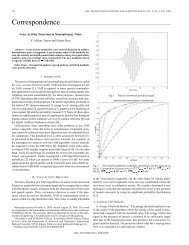Time Difference of Arrival Estimation of Speech Source in a Noisy ...
Time Difference of Arrival Estimation of Speech Source in a Noisy ...
Time Difference of Arrival Estimation of Speech Source in a Noisy ...
Create successful ePaper yourself
Turn your PDF publications into a flip-book with our unique Google optimized e-Paper software.
EE049035 – Spr<strong>in</strong>g 2007<br />
<strong>Speech</strong> Quasi-Stationarity<br />
Consider the observation time <strong>in</strong>terval <strong>of</strong> length NP:<br />
The noise is stationary<br />
The speech stats are chang<strong>in</strong>g.<br />
By divid<strong>in</strong>g the observation <strong>in</strong>terval to N frame <strong>of</strong> length P ,<br />
the speech is stationary for each frame.<br />
Assume the analysis w<strong>in</strong>dow <strong>of</strong> length P is much larger than<br />
the support <strong>of</strong> a ( t), b ( t)<br />
(MTF assumption):<br />
m m<br />
Z ( n, w) = A ( w) S( n, w) +<br />
B ( w) N( w)<br />
m m m<br />
Therefore, for each frame, n = 1,..., N :<br />
Φ ˆ = Φ ˆ + Φˆ<br />
( n, w) H ( w) ( n, w) 1 ( n, w)<br />
m 1 1 1<br />
m<br />
z z m z z b<br />
17















